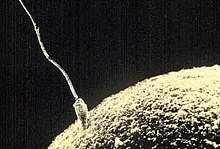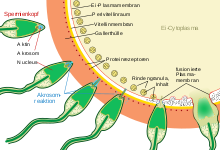fertilization

The fusion of germ cells ( gametes ) in the context of sexual reproduction is usually referred to as fertilization or fertilization . In the narrower sense, it means the fusion of the cell nuclei ( karyogamy ). The result of fertilization is the zygote , which contains the genetic material of both parents. The doubling of the chromosome number during fertilization leads to diploidy and is later reversed by meiosis (reduction division) in the cells from which the gametes arise in the new generation .
In the past, fertilization was also understood as the penetration of sperm into the vagina , but today this is referred to as insemination , in plants this corresponds to the appearance of pollen on the female flower organ, pollination . Therefore, the terms are still often confused today. However, insemination or pollination is the process that precedes actual fertilization.
Types of fertilization
In humans and in all multicellular animals (Metazoa), the female gamete is an immobile egg cell, the male a mobile sperm . In this case, fertilization is called oogamy . This is also found in land plants and in some algae , although the seed plants do not have freely moving male gametes, but rather form a pollen tube that brings the sperm cell to the egg cell ( siphonogamy ). In most algae, the gametes of both sexes are motile by flagella . If they do not differ externally, one speaks of isogamy , while in anisogamy the female gametes are larger than the male. Fungi do not form gametes. In them, fertilization occurs when special reproductive organs ( gametangia ) fuse with one another ( gametangiogamy ) or when ordinary hyphae simply fuse ( somatogamy ).
In animals, a distinction is made between external fertilization , in which the sex cells fuse outside the body (for example in most fish, see spawning ) and internal fertilization , which takes place in the body of the female. This is the case with all amniotic land vertebrates, including humans, but also with sharks, some bony fish and many insects and arachnids. With internal fertilization it is necessary that the sperm reach the egg cell in the female body before the actual fertilization. With some living beings this happens without physical contact, with others the sperm are actively introduced into the female body. The introduction of sex cells into a body (for later fertilization) is called insemination , copulation , sexual act or germination of pollen , depending on the case .
For the fertilization of an egg cell in humans see procreation .
In an in vitro fertilization or artificial insemination ( insemination ) the germ cells are brought through human intervention to each other:
- In vitro fertilization : the germ cells are brought together in the test tube and fertilization takes place in it under laboratory conditions.
- After an insemination, i.e. the artificial transfer of sperm into the genital tract of the woman (or a female animal), the actual fertilization (fusion of the germ cells) takes place naturally. A distinction is made between homologous and heterologous insemination .
- In artificial pollination, pollen is applied artificially (for example with a fine brush) to the female flower organ . Fertilization occurs naturally after the pollen tube has grown.
Web links
- Lexicon of biology : fertilization . Spectrum, Heidelberg 1999.
Single receipts
- ^ V. von Hensen: Observations on the fertilization and development of rabbits and guinea pigs. In: Z. Anat. Dev Gesch. Volume 1, 1876, pp. 353-423.
- ↑ Christian Conrad Sprengel: The discovered secret of nature in the construction and fertilization of flowers. Berlin, Vieweg 1793. (books.google.com)

